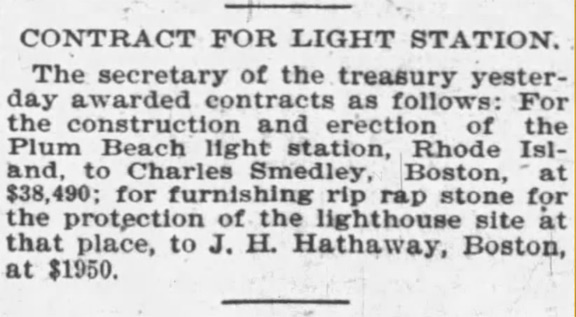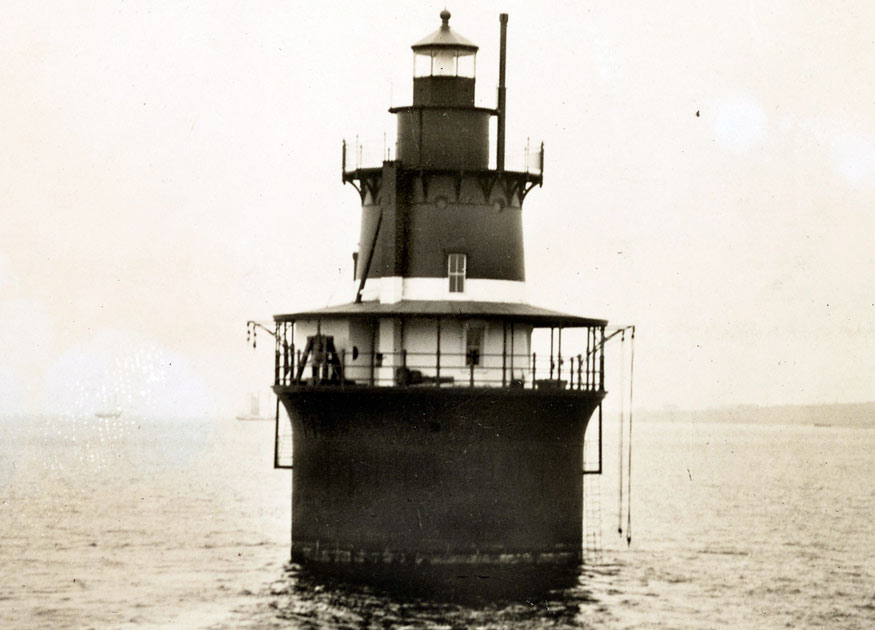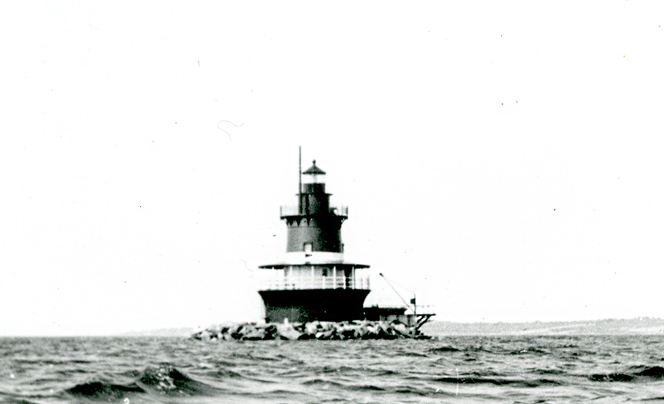In 1896 a pneumatic caisson, an air tight metal structure, the lower part of Plum Beach light's thirty-three foot diameter metal foundation, was towed from Providence to Plum Beach and was sunk. Once the caisson settled to the bottom, the water inside was pumped out and it was filled with air. Workers went into the caisson and removed the soil underneath it, allowing it to sink to thirty-eight feet below mean low water. As it sank, metal plates were added to the top of the foundation. In early December, a test boring showed a seven-foot layer of quicksand at the thirty-eight foot depth. If the caisson was left at this depth the lighthouse would be unstable. The caisson would have to be placed seven feet deeper. This also meant that the foundation would have to be heightened but there wasn't enough money in the budget to do that. The lighthouse Board stopped construction on the light. The top of the unfinished foundation was covered with a wooden peaked roof. On February 1, 1897 a temporary red lantern was suspended from a bracket on top of a mast on the foundation.
| Awarding Contract for Plum Beach Lighthouse |
|---|
 |
| Fall River Globe (Fall River, MA) -June 27, 1896 |
In 1898, $9,000 was appropriated to complete the light. An additional row of metal plates was added to the foundation, before weather halted work in January 1899. In April work resumed on the lighthouse. It was finally finished on June first. A fourth order Fresnel lens was installed in the lighthouse and it was first lighted on July 1, 1899.
S. G. Wright was put on trial, in early 1916, for illegally selling alcohol. Plum Beach Lighthouse's Keeper Judson G. Allen was his main defense witness. He testified Wright was at the lighthouse, when the alcohol sale was made. The lighthouse's assistant keeper also testified at the trial. He swore that neither Wright or Allen were at the lighthouse, at the time the alcohol sale was made.
A Rhode Island Liquor officer charged Allen with perjury. When the Lighthouse Board heard about the perjury charge, they started an investigation.
After the Lighthouse Board finished their investigation, it didn't find enough evidence to accuse him of perjury. It also didn't clear him. It said, "that it could not determine which of the men had not told the truth at the trial, and that the entry in the journal of Wright's presence there was open to criticism." Allen resigned after he received the result of the investigation.
In October 1916 Plum Beach Lighthouse keeper Charles Ormsby went on a short leave. Assistant keeper John H. Boldt was left in charge of Lighthouse. When Ormsby returned from his leave on October 24, he found Boldt dead in the lighthouse's kitchen. It was believed that Boldt died of natural causes on October 23.
On January 28, 1928 a minor snowstorm hit Rhode Island. Keeper Ormsby was on shore when the storm hit Rhode Island and the lighthouse was unattended. He tried to row back to the lighthouse but the rough water flipped his boat over. He swam back to shore. The lighthouse service tender Pansy tried to put a man on the lighthouse but water was too rough. They were able to put a man on the lighthouse the next day.
On September 21, 1938, substitute keeper Edwin Babcock tried to row ashore to see his family but wind and high waves caused by the approaching 1938 Hurricane forced him back to the lighthouse. He and assistant keeper John Ganze knew a bad storm was coming. They secured the light and waited. As the storm grew in intensity, the light was hit by bigger and bigger waves. A thirty-foot wave hit the lighthouse and tore open the kitchen door. Water poured into the lighthouse. The keepers climbed up to the fog bell room. It was the highest, non-exposed point on the light. They tied themselves, back to back, to the pipe containing the weights that turned the Fresnel lens in hope their bodies would be found together if the lighthouse were destroyed. The keepers survived, but the light was badly damaged. Minor repairs were made to the lighthouse and it was put back into service.
In 1941, the first Jamestown Bridge was built almost on top of Plum Beach Lighthouse. The lighthouse was no longer needed as an aid to navigation and was closed. The Coast Guard put the lighthouse up for auction. The high bidder would have to tear it down and remove it. No one bid on it.
The Cannon Paint Company of Philadelphia was hired to paint the Newport Bridge in 1973. James Osborn, Cannon employee, was taken off his job painting the bridge and was ordered to paint Plum Beach Lighthouse. While he was painting the lighthouse, he contracted histoplamosis, an eye disease, from pigeon feces that filled the lighthouse. In 1984 he sued the state for $500,000. The case was in court for years.
In 1974 two scientists were studying the pigeon colony that lived in Plum Beach Lighthouse. They found that pigeons deserted about 40 percent of their eggs. They thought it was a form of birth control because there were no predators in the lighthouse. When the two scientists reduced the lighthouses' pigeon population, the birds deserted fewer eggs.
In 1988 O'Connell Development of Quincy, Massachusetts wanted to move Plum Beach Lighthouse to a breakwater at Marina Bay, its condominium development in Quincy. There was a problem; they could not find the owner. The Coast Guard said ownership of the lighthouse reverted to Rhode Island when they abandoned it. The Rhode Island Attorney General's Office disagreed. It said, the Coast Guard may have abandoned the lighthouse, but it never gave the state the title. Without a title, the state does not own it. Neither side wanted to claim the lighthouse, because of the lawsuit. O'Connell Development later hired an architect to plan a lighthouse from scratch.
The Friends of Plum Beach Lighthouse, Inc. was formed in response to O' Connell Development's attempt to buy the lighthouse. The group wanted to acquire the light and restore it. Their efforts to get the lighthouse were frustrated for a number of years because of the uncertain ownership.
In 1998 the Rhode Island Superior Court decided that the state owned the light. The court ordered the state to pay $42,000 to James Osborn. With the question of ownership finally resolved, the state decided to give the Friends of Plum Beach title to the lighthouse.
In 2003 Abcore Restoration started on the restoration of the lighthouse. The first step of the restoration was the removal of over 50 tons of guano left by the birds that lived in the lighthouse. After the interior was cleaned out the lighthouse exterior was repainted and repaired. In December a new light was placed in the lighthouse and it was lighted for the first time in 62 years.
In the years after the 2003 restoration, the Friends of Plum Beach Lighthouse had trouble raising enough money to repaint the lighthouse and for yearly maintenance of the lighthouse. In October 2009, the Friends received state approval to sell license plates to raise money. They had to sell a minimum of 900 Plum Beach Lighthouse plates before the Rhode Island would produce them. It only took eight weeks to sell more than 900 PBL plate. The plates cost $41.50 per set, $20.00 to Friends of Plum Beach Lighthouse and $21.50 goes to the state.
With the money from the sales of the license plates, the Friends of Plum Beach Lighthouse raised enough money to paint the lighthouse. During the summer of 2010, Abcore Restoration painted the lighthouse. If you live in Rhode Island and want to help Plum Beach Lighthouse, buy the PBL plate.
A Tour of Plum Beach Lighthouse
For information
on the Friends of Plum Beach Lighthouse, Inc., contact:
Friends of Plum Beach Lighthouse, Inc.
P.O.Box 1041
North Kingstown, RI 02852
Friends of Plum Beach Lighthouse, Inc.
P.O.Box 1041
North Kingstown, RI 02852

